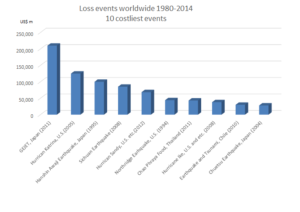In 2011, Great East Japan Earthquake and Tsunami (GEJET) disaster and the Chao Phraya River flood disaster made huge economic damages. They are in the top 10 costliest natural disasters (The very top and the 7th) in the world as you can see the following table.
Source: NatCatSERVICE/Munich RE 2016
From the historical point of views, the disaster trends from human sufferings to economic damages. The following figure shows the economic damage tendency is increasing with time and we can see the year of 2011 was an outstanding.

Source: EM-DAT
Especially, the globalization of the economic activities reflect these damages.In the event of large-scale disaster, a business sector is limited in its abilities to cope with disaster without the cooperative approach taken by the stakeholders of the public and private sectors in those areas.
With this situation, the concept of the Area Business Continuity Management (Area BCM) was revealed. This is a cooperative approach by those who wish to improve capacity for continuity and/or early recovery of business in their area in the event of disasters that affect the entire area(AHA CENTRE et al., 2015).
[Reference]
AHA CENTRE, JICA, et al., (2015) Planning Guide for Area Business Continuity: Area BCM Toolkits Version 2
sponsored link







